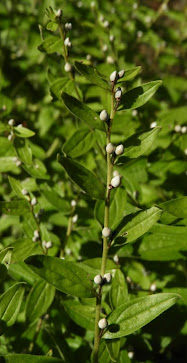These three were found near the railway station in Lydney, Gloucestershire and photographed over a couple of months to catch the seed heads.
- Scarlet Pimpernel, Lysimachia arvensis
- Sticky Groundsel, Senecio viscosus
- Black Nightshade, Solanum nigrum
Scarlet Pimpernel, Lysimachia arvensis
This native plant, usually an annual, from the Primulaceae family has a number of names that refer to its sensitivity to light: Poor Man's Weatherglass in Somerset, Weatherflower in Dorset and Wink-and-Peep in Shropshire. The flowers open in good light at about 8am and close about 3pm. They will close or remain closed in dull, wet, or humid conditions.
The five petals have a reddish-purple base and there are five sepals and five stamens with bright orange anthers.
It has a square stem, the leaves are opposite and always face the light with the solitary flowers on stalks in the leaf axils.
The seed capsules are urn shaped splitting around the circumference to divide into two halves to enable the wind to scatter the seeds. The stalk, which is initially straight, curves back as the seed ripens. The stalk curve and the developing split can be seen here.
Grigson describes the split seed capsule hinging backwards like a crested skull-cap. I can see what he means!
Herbally it was used against many afflictions: toothache, snake bites, epilepsy, kidney problems to just begin.
It was credited with relieving eye problems. In Ireland it was a "blessed herb" and if held in the hand it was said to give second sight and hearing, plus allowing the holder to understand the speech of birds and animals.
It appears in the Herbals and Vocabularies of the sixteenth century as Bipinella and its use as a cosmetic herb persisted until the nineteenth century when Pimpernel Water was used to bleach freckles.
Pliny refers to its value in treating liver complaints and the former botanical name Anagallis , given by Dioscorides, is said to be derived from the Greek to laugh and indeed the herb was used to dispel sadness.
Local names in Somerset include Laughter Bringer and Shepherd's Delight.
If you were in any doubt about the effect of this plant here is an unattributed rhyme:
No heart can think, no tongue can tell
The virtues of the Pimpernel.
There will be new plants in bloom again next April.....
Sticky Groundsel, Senecio viscosus
I saw this growing in a classic habitat for it: disturbed ground on gravel in a man-made habitat: a railway car park. At first I just thought it was a stunted Ragwort but then I realised it was the locally common - but never before seen by me - Sticky Groundsel. The fine ray-florets which quickly turn downwards are key to ID.
The stem is wavy and well branched.
The foliage is covered in sticky glandular hairs which can be seen too on the calyx above .
I read about the naming of the genus Senecio from senex meaning old man. A sixteenth century herbalist wrote:
The flower of this herbe, hath white heere, and when the wind bloweth it away, then it appereth like a bald headded man therfore it is called Senecio.
In the photos below you can see exactly what he meant. The seed-heads leave behind a round head-like shape which is slightly shiny.
The seeds are brown, cylindrical and ribbed.
This member of the Asteraceae family is a naturalised neophyte. It was recorded in Britain by John Ray in 1660 who noted it was plentiful in the Isle of Ely. It may be native on sandy and gravelly soils.
Here it probably came in on the gravel/ chippings for the car park and it is thriving. Several plants are in the vicinity of this one.
It has the following local names: Ashwort which is interesting, Stinking Groundsel interesting and helpful, and Sticky Ragwort probably unhelpful!
Black Nightshade, Solanum nigrum
A member of the Solanaceae family this is a native and introduced. Here it sprawls through a hedge near the old railway line down to Lydney Harbour. It is a common annual and a cosmopolitan one spreading almost around the globe in appropriate habitats. Wikipedia says it is native to Eurasia and introduced to the Americas, Australasia and South Africa.
It has white petals initially spread flat then bent back. The anthers are long and yellow. There is a single lime-green semi-globular style protruding from the anthers.
The stem is a dark purple-black, variably hairy and the leaves dark green, wrinkly and variably toothed.
It has the reputation of being poisonous and it was called Petty Morel by the older herbalists to distinguish it from Great Morel - Deadly Nightshade. Culpepper warns "Do not mistake the deadly nightshade for this, if you know it not, you may then let them both alone"! It contains Solanine in varying strengths according to the season. Most cases of poisoning result from eating the leaves or unripe fruit. The green unripe fruit can be seen forming here. The berries turn a shiny black when ripe.
It has a long history of medicinal use but was considered a risky remedy. One or two grains of dried leaves were infused with boiling water and used to induce sweating. Bruised fresh leaves applied externally were said to ease pain and inflammation. In the Middle East the leaves were applied to burns and ulcers.
Surface applications are considered much safer than internal ones!
I plan another blog on plants of Gloucestershire soon. Thank you for reading this one.
Acknowledgements
Simon Harrap's Wild Flowers
Stace 4
Grigson The Englishman's Flora
Mabey Flora Britannica
Wikipedia
http://botanical.com/
http://seasonalwildflowers.com/
http://wildflowerfinder.org.uk/
http://www.wildflowerweb.co.uk/
www.brc.ac.uk























